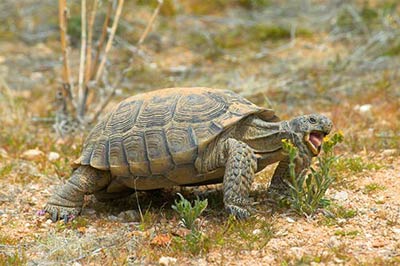Desert Tortoise (Gopherus agassizii)

The desert tortoise is designated California’s State reptile and is found in the Mojave and Sonoran Deserts of Southern California. They inhabit semi-arid grasslands, gravelly desert washes and sandy canyon bottoms below 3,500 ft. The desert tortoise has a domed, brown shell (carapace) 9-15 inches long and 4-8 inches high, and muscular, flattened front legs with long claws adapted for digging deep burrows underground. The tortoise can weigh between 8 and 15 lbs., and live to be 80-100 years old. Tortoises eat herbs, grasses new growth of cactus and annual flowers.
95% of a tortoise’s life is spent underground. To escape the heat of the summer and cold of the winter desert tortoises live in burrows, which they dig. Tortoises spend November through March in hibernation. Their most active time is in the spring when they mate and forage for food. Desert tortoise will dig catch basins in the soil to catch the infrequent rain that falls. They remember where the basins are and return to them when it rains. Most of their water intake comes from moisture found in the grasses and wild flowers they eat in the spring. The tortoise has the ability to store about a quart of water in its bladder to be used when necessary.
The desert tortoise will mate anytime it is above ground. The female lays a clutch of 1- 14 hard-shelled eggs in a nest in May, June and July, and leave the nest to be incubated by the warm soil. After incubating for 70 to 120 days the young tortoises hatch. Female tortoise does not provide care for their young.
Only 1 to 5 of every 100 hatchlings will survey to adulthood. Hatchlings are about the size of a silver dollar. Their shells stay soft for the first 5 years and coyote’s, roadrunners, and ravens prey them upon. Ravens account for the death of about 50% of the juvenile tortoises.
It is unlawful to touch, harm, harass or collect a wild desert tortoise. Keep your distance if you ever see a desert tortoise in the wild. When frightened they will empty their bladder, and the loss of water can be fatal to the tortoise. The desert tortoise is a threatened species under the California state Endangered Species Act in 1989 and the federal Endangered Species act in 1990.
Illegal collection for the pet trade, destruction of their habitats by urban area expansion and off-road vehicles, and increased predation by ravens are some of the factors contributing to the desert tortoise’s decline. The population of the desert tortoise in the Mojave Desert has declined by 90% since 1980.
Even though a desert looks empty and lifeless, it is filled with so many species of animals, like the desert tortoise, who need our special consideration.
Information on Federally-listed threatened and endangered species can be found at the U.S. Fish and Wildlife website at http://www.fws.gov/endangered/. Information on State-listed threatened and endangered species can be found at the California Department of Fish and Game website at https://fgc.ca.gov/CESA.